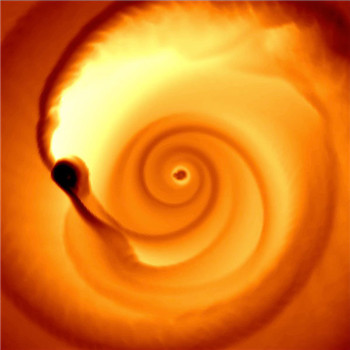
The apocalypse is still on, apparently — at least in a galaxy about 3.5 billion light-years from here.
看起来,末日仍然会上演——至少是在距离我们35亿光年的一个星系。
Last winter a team of Caltech astronomers reported that a pair of supermassive black holes appeared to be spiraling together toward a cataclysmic collision that could bring down the curtains in that galaxy.
过去的这个冬天,加州理工的一群天文学家发布论文称,一对超大质量黑洞似乎在朝着灾难性碰撞的轨迹运行,而这种碰撞可能会宣告该星系的落幕。
The evidence was a rhythmic flickering from the galaxy’s nucleus, a quasar known as PG 1302-102, which Matthew Graham and his colleagues interpreted as the fatal mating dance of a pair of black holes with a total mass of more than a billion suns. Their merger, the astronomers calculated, could release as much energy as 100 million supernova explosions, mostly in the form of violent ripples in space-time known as gravitational waves that would blow the stars out of that hapless galaxy like leaves off a roof.
他们的证据是这一星系中心的类星体PG 1302-102表现出了一种有规律的闪动。研究人员马修·格雷厄姆(Matthew Graham)及其同事认为,这代表了一对总质量超过太阳10亿倍的黑洞在互相环绕,走向死亡。根据他们的估算,二者合并或许可以释放出1亿颗超新星爆炸的能量,多数表现为“引力波”。这种时空中的猛烈涟漪会让星体从那倒霉的星系中喷出,好比是从屋顶上刮走树叶。
Now a new analysis of the system by Daniel D’Orazio of Columbia University and his colleagues has added weight to that conclusion. Mr. D’Orazio, a graduate student, and his colleagues Zoltan Haiman and David Schiminovich propose that most of the light from the quasar is coming from a massive disc of gas surrounding the smaller of the two black holes.
现在,哥伦比亚大学(Columbia University)的丹尼尔·德奥拉齐奥(Daniel D’Orazio)及其同事对这一星系进行的新分析,给上述结论增添了份量。研究生德奥拉齐奥和同事佐尔坦·海曼(Zoltan Haiman)、戴维·希米诺维奇(David Schiminovich)提出,这颗类星体发出的光多数来自围绕着其中一个较小黑洞的硕大的吸积盘。
As the black holes and their attendant discs swing around each other at high speeds, the light from the disk that is coming toward us gets a boost from relativistic effects – a so-called Doppler boost — the same way a siren gets louder and more high-pitched as it approaches, giving rise to a periodic increase in brightness every five years.
这两个黑洞及其吸积盘相互高速旋转时,来自这个吸积盘的光线在对着地球的方向会因相对运动产生的多普勒效应而加强——好比对面驶来的火车鸣笛声会变得更大声、更尖细一样——令它每隔五年会周期性地增大亮度。
The Columbia astronomers’ model predicts that the variation would be two or three times greater in ultraviolet light than in visible light. And that is exactly what they found when they compared archival data from the Hubble Space Telescope and NASA’s Galex space telescope to the visible-light data previously analyzed by Dr. Graham’s group.
哥伦比亚大学的这三名天文学家建立的模型预测,其中紫外线的变化会比可见光显著。他们拿出哈勃太空望远镜和美国航空航天局的星系演化探测器(Galex)的历史数据,与格雷厄姆团队之前分析的可见光数据进行比对,发现结果正好与预测吻合。
“What’s big is that the Doppler boost is inevitable,” Dr. Haiman said in an email. Given reasonable assumptions about the masses of the two black holes, their model predicts the right ultraviolet data. “This is rare in ‘messy’ astronomy,” he said, “to have an indisputable clean effect, which explains the data.” Follow-up observations of ultraviolet and visible light emissions in the coming years could help the clinch the case, the authors said. Their paper was published on Wednesday in the journal Nature.
“其中的重大意义在于,这只能是多普勒效应,”海曼博士通过电子邮件接受采访时表示。只要给出有关这两个黑洞质量的合理假设,他们的模型就能预测出准确的紫外线数据。“在‘混乱’的天文学研究中,很难看到有一个毫无争议的清晰理论能够对数据做出解释,”他说。三名研究人员表示,未来几年对紫外线和可见光辐射的追踪观察或将有利于得出确凿的结论。他们的论文于本周三发表在《自然》杂志(Nature)上。
Their model suggests that the black holes are orbiting each other at a distance of some 200 billion miles, less than a tenth of a light-year, a cosmic whisker. At that distance the black holes would be rapidly losing energy by radiating gravitational waves and could spiral together into the final bang in as little as 100,000 years, Dr. Haiman said, depending on their relative masses.
他们的模型显示,两个黑洞在相互环绕,之间的距离约为2000亿英里,不到0.1光年。这在宇宙中可谓紧密相连。海曼称,相距这么近的话,这两个黑洞应当以发出引力波的形式快速丧失能量,并且可能会最快在10万年后最终相撞。
“Basically, the more massive the holes, the faster gravitational waves drive them together, and we do require them to be as massive as allowed to be,” he said in an email. For their model to hold up, the larger of the black holes has to be a billion solar masses or more.
“基本上,双黑洞质量越大,引力波将他们拉到一起的速度越快,而我们的研究的确假定他们在允许的范围内质量尽可能地大,”他在邮件中写道。他们的模型要想成立,双黑洞中较大的那个的质量至少得相当于10亿个太阳。
E. Sterl Phinney, a Caltech astronomer and expert on supermassive black holes currently on sabbatical at Radboud University in the Netherlands, agreed that Dr. Haiman’s model explains the quasar variations. “So Occam’s razor makes it attractive,” he said in an email, referring to the long-held principle that physicists should adopt the simplest theory that fits the facts.
加州理工的天文学家E·施特尔·菲尼(E. Sterl Phinney)是超大质量黑洞领域的专家,目前在荷兰的内梅亨大学(Radboud University)休学术假。他认为海曼的模型能够解释这颗类星体的闪动。“奥卡姆剃刀让它讨人喜欢起来,”他在接受采访的电子邮件中写道。奥卡姆剃刀是一个由来已久的原则,认为物理学家们应该采用最简洁的理论来解释事实。
But it was surprising, he said, to find a pair of supermassive black holes that have gotten so close.
不过他也表示,找到距离如此相近的一对超大质量黑洞令人意外。
Black holes, predicted by Albert Einstein’s general theory of relativity, the prevailing theory of gravity, are objects so dense that not even light can escape from them. In effect they are bottomless pits in space-time. Every galaxy of note seems to have a supermassive black hole, weighing millions or billions of times as much as the sun, burping sparks of half-eaten stars and gas.
阿尔伯特·爱因斯坦(Albert Einstein)的广义相对论是有关引力的权威理论,其中预测了黑洞的存在。黑洞十分致密,以致于光线都无法从中逃脱。它们实际上是时空中的无底洞。每个重要星系似乎都有一个质量为太阳无数倍的超大黑洞,不断辐射出正被吞噬的星体和气体的闪烁光线。
When galaxies merge, their resident black holes are sent into forced marriages, orbiting each other. But without gravitational interactions with stars or interstellar gas, supermassive black holes can’t get close enough to each other to go into a rapid death spiral, a situation known as the “final parsec” problem. (A parsec is the astronomical standard of distance, 3.26 light-years.)
当星系合并的时候,各自的黑洞被迫拴在一起,相互环绕运动。不过,如果没有与星体或星际气体之间的相互牵引,超大质量黑洞不能靠近到能迅速走向碰撞的地步,而这种现象被称为“最后的秒差距”问题(秒差距是天文学距离单位,1秒差距等于3.26光年)。
So, as Dr. Phinney explained, unless hundreds of millions of solar masses of gas accompany the black holes, “there are not very convincing ways of getting them to smaller separations” like the black holes in PG 1302-102.
因此,正如菲尼解释的那样,除非双黑洞周围有数亿太阳质量的气体,“没有令人信服的办法来让它们的距离缩小”到PG 1302-102的两个黑洞那么近的地步。
At least that is the theory. If such systems are common, Dr. Phinney said, the gravitational waves emanating from them should sweep the universe and disrupt the timing of signals from pulsars, an effect that could be detected within the next few years by various ongoing programs to time pulsars.
至少理论上如此。菲尼称,假如这种系统很常见,那么从中发出的引力波应该席卷整个宇宙,干扰到脉冲星信号的节奏,那么在未来几年里,目前正在进行的多个观测脉冲星时间的项目就应该可以观察到这一现象。
“A scientific theory is only as good as the tests which it has passed,” Mr. D’Orazio said in an email. Although general relativity has passed all of the observational and experimental tests thrown at it so far, some of its predictions can only be tested in the most extreme gravitational environments, namely black holes. “Detection of gravitational waves,” he said, “is a direct probe of this region and hence the secrets of gravity.”
“科学理论的正确性是由它经受的考验决定的,”德奥拉齐奥在邮件中表示。尽管广义相对论经受住了迄今为止所有与之相关的实验和观测的考验,但该理论蕴含的一些预测只能在最极端的引力环境中检验,也就是黑洞。“观测引力波是对这种区域的直接探究,继而也是对引力的奥秘的直接探究,”他说。











